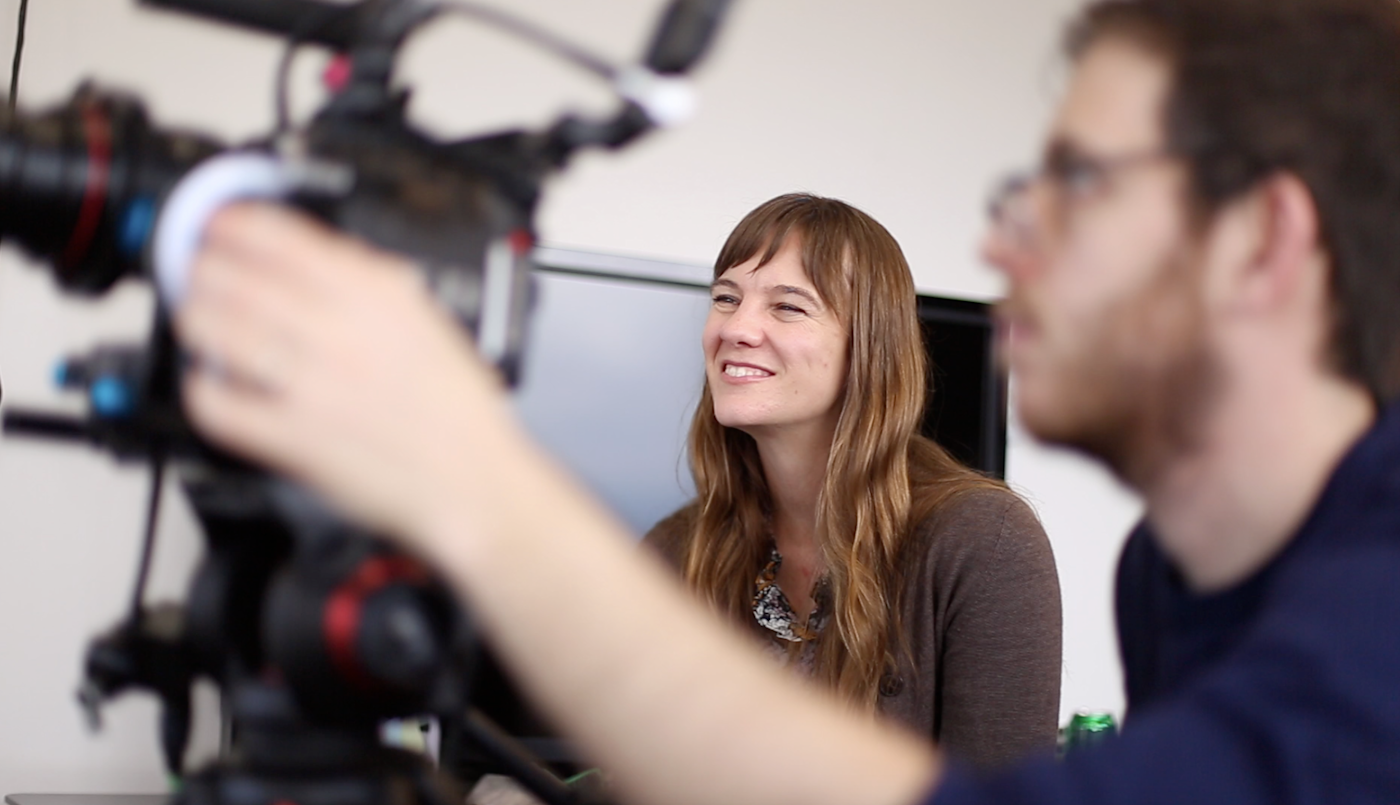
Video shows emotion, emotion builds trust, and trust gets you customers
By Kerri Fernsworth Feazell · March 5, 2021
When I was a little girl, I was so shy that I often smiled with my lips curled around my teeth. My best guess on the logic of my former self goes something like: if I don’t show my teeth, the chance that I might accidentally talk while in a parade is reduced.

While I haven’t met any business owners who match the shyness of curled-lip Kerri, my own experience with shyness affords me great empathy for clients with any level of camera shyness.
It’s weird to be on camera. There are bright, hot lights, a crew of people staring at you, every move you make and word you say is being recorded. Then, an editor will review the footage repeatedly and meticulously edit out your ums and uhs. It makes me sweat just to think about it.
So, I get it. And the reason I started this blog with a personal story is that I believe so much in the power of vulnerability to build trust. Your own authenticity is your superpower. And that authenticity can shine through so brightly with video.

Why is video an effective medium to establish trust?
When someone discloses even a little bit about themselves, you can connect with them as a human. And video is a powerful format to convey not just information, but emotion.
Unusually famous for his teeth, Tony Robbins agrees: “People buy feelings, not things.” As a business owner or executive leader, when you make a personal, emotional connection with your customers and prospects in video, you earn their trust—and you’re more likely to earn their business.
Video vs. in-person introductions
I like people, and I miss meeting new business colleagues at networking events. I’ve gotten a lot of practice not being shy over free carrots and ranch dip (for dinner). But when in-person meetings aren’t possible or practical, we have to figure out how to effectively use alternate forms of connecting with other humans.
Even virtually, there’s still a chance to personally introduce yourself to your audience, so they can meet the people behind the scenes. Video opens up this door, and sometimes, it’s the best choice regardless.
For example, is it likely that I’ll sit down for coffee with the managing partner of the accounting firm I’m considering hiring? Probably not. But video gives me a way to hear from him directly. And he has a chance to skip the small talk and tell me what he cares about and how he values his team. That’s probably not something I would hear about otherwise.
This is exactly the opportunity recognized by Ken Pun, managing partner of The Pun Group, an accounting firm in Orange County. So here we are online—go ahead and grab a cup of coffee to hear from Ken to get a better sense of what I mean (in under two minutes).
Recorded video vs. virtual meetings
According to neuropathophysiology research, Zoom fatigue is real. If you feel a bit daunted by the idea of sitting in front of cameras and a production crew for a few hours, I understand. For me, it takes a lot of energy to be “on” in that way. And virtual meetings have some similar drawbacks as sitting in front of a camera crew.
But there’s a way to make your energy spent in front of cameras more efficient.
For example, if you take a lot of time with new clients or prospects answering many of the same questions repeatedly, you could use recorded video instead of a virtual meeting.
I run a production company to serve business leaders. When I’m conducting interviews, I ask my clients to look directly at me instead of into the camera. So it feels like a human connection is actually being made in a video because that actually is what’s happening. Even if the video audience isn’t making the direct connection themselves, it still exists. That makes a difference. And, in some scenarios, it can save not just money or time but also what I’d quantify as vital life energy to use a recorded video in place of a virtual meeting.
Here’s an example. HazardHub hired us to record a brand video, which we did in one full day. In our interview process, we had about four hours of recorded footage, and only about two minutes of that footage goes into a brand video. The additional 3 hours and 58 minutes of footage is purposefully robust. So we organized that footage into a 14-video FAQ series. HazardHub can then use those videos in response to questions they receive from prospective clients.
You can watch the following video and see how it could effectively be used in a sales situation if faced with a price-related question. Rather than asking their prospect for a virtual meeting, in 1 minute and 34 seconds, a confident and compelling case is made. With this approach, HazardHub can spend their energy on other kinds of customer care.
Video vs. text
For small business owners, personality, story, and passion are often key selling points. It’s a huge advantage over your larger competitors. But it’s really hard to convey that in text. I can’t fault anyone for trying, but does this sound familiar?
-
We pride ourselves on customer service.
-
With a small and dedicated team, we cater to every client’s unique needs.
-
Small town service in a big city.
The thing that kills me is that these statements are probably true—but they are extraordinarily hard to believe in text. They sound generic. They’re passionless. There’s no personality behind them. Passion and personality are exactly what small businesses really have going for them. Video can be a remarkably effective method to get this across.
Here’s an example of a video we created for an in-home, high-end yoga instructor. Notice how Rachel talks about how she feels, her passions, what she personally cares about. Notice her body language. These are all things you would pick up on subconsciously, even if you weren’t tuned into them.
5 tips for using video to establish trust with customers
1. Be yourself
The simplest things are always the hardest. I know that when I take my own advice and appear in my own video and share my story (as it relates to my customers), it works. As much as I want to hide and ask someone else to appear for me, I know that’s not the right move to build my business. You need to represent your brand.

2. Skip the script
It’s completely natural to think that making a video with the exact right words in the exact right script will make everything go smoothly. But if you’re not an actor, it can be very awkward. And that will undermine your confidence. Instead, use an interviewer and go documentary style. Even having a friend behind the lens who can lead you through a conversation is so much better than trying to get it “right.” (There is no right.)
It can actually be quite simple to use some interviewing techniques. You’re not required to film a live stream video, so turn on your camera and try filling in the blank on a few sentences and just see what happens:
-
I love what I do because…
-
What gets me up in the morning is…
-
I get excited when…
It also helps tremendously to take yourself less seriously. What really matters to you? Talk about that, and you might be able to forget yourself.
3. Make a human connection
Focus on empathy and why solving your customers’ problems matters to you personally. If you’re a founder, what motivated you to start your company? Your customers want to hear your personal story. I want to invest my customer dollars with you over big-box alternatives because I know you have a soul.
Animated explainers and how-to videos can serve a valuable purpose, but it’s a different purpose. Providing information does not make an authentic emotional connection. Be one of over 53 million people who can quote Simon Sinek and “start with why.” Once you capture attention, then talk about how you do it and what you offer.
4. Let your customers speak for you
Customer testimonial videos are very effective (but only if they are totally natural—see #2 above). They can be a great opportunity for cost-conscious entrepreneurs to experiment with DIY-style video. We encourage this format especially for this purpose because it adds credibility and authenticity in a customer endorsement. Here’s an example we created for Gravity Payments, shot 100% on an iPhone 6. (If you do this yourself, a good ring light and mini tripod are worthwhile purchases for about $80.)
5. Hire an editor who can tell a story
The story is made in the edit. A technically great editor, who knows where to find stock footage and music, might be enticing. But that skill doesn’t necessarily mean your editor knows how to tell a great story. Flashy lifestyle videos with beautiful footage can convey a mood, but they don’t establish trust. Yes, you have to relate to your customers and investors, but you also need to give them a reason to believe in you.
If you already have footage, hiring a professional editor can be well worth your money. One idea is to check out a deeply independent short film library like this one and watch some short films. Find a film you love, and see if you can track down the editor on LinkedIn to edit your company video. You might get lucky. (And if you happen to like my short film up there, I might get lucky!)
If you’re creating pre-recorded videos, you can automate your video post-production tasks to streamline the process.
Summary with key takeaways
-
Video can’t replace in-person or virtual meetings. But, when done in a specific way, it’s a vital life energy-efficient way to share your personality, especially when in-person meetings aren’t possible or practical.
-
Compared to virtual meetings, you can sometimes replace video early in your marketing and sales funnel. This can also be a way to weed out time-wasters in your sales pipeline while you automate a process and showcase your expertise. Complement it with a more personal customer service touch in another creative way.
-
Video has advantages over text in that it conveys authentic emotion and passion through body language and intonation. Your audience picks up on “do I believe you?” cues from video that are hard to convey in text or even undermined in overly eager text.
-
Show up. Be yourself. Smile with teeth.
Kerri is the co-CEO and co-founder of Concurrentand Authentic Advisor Video. She also hosts the podcast I Reinvented My Life in Business and co-launched the course How to Make a Brand Video that Isn’t Boring.
Get productivity tips delivered straight to your inbox
We’ll email you 1-3 times per week—and never share your information.
Related articles
Improve your productivity automatically. Use Zapier to get your apps working together.












